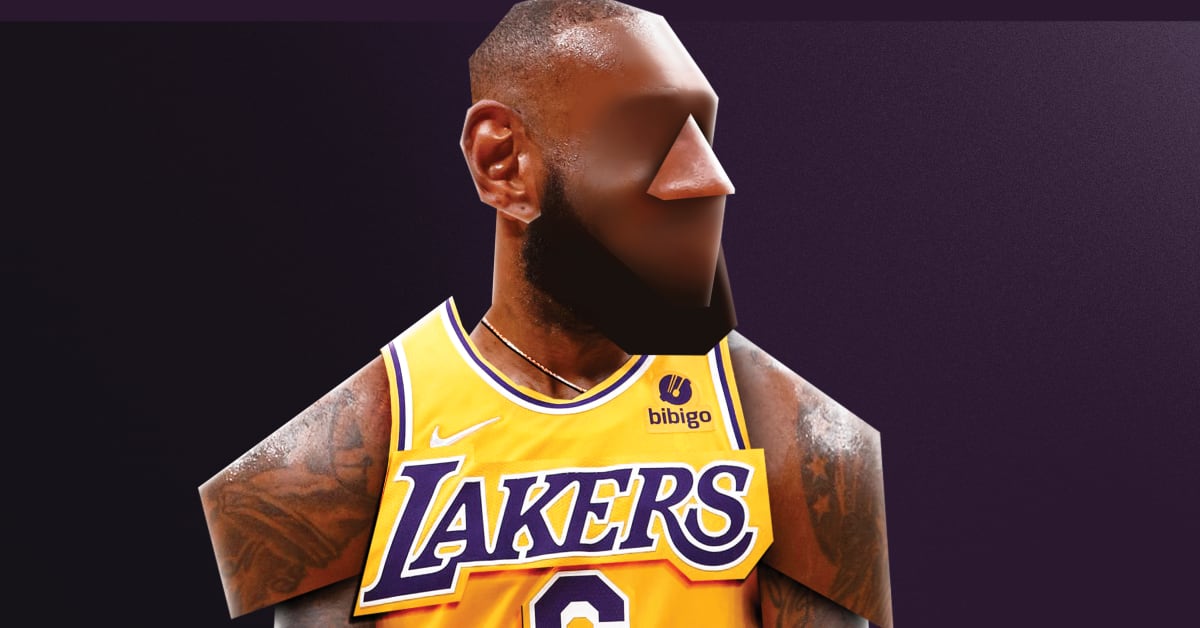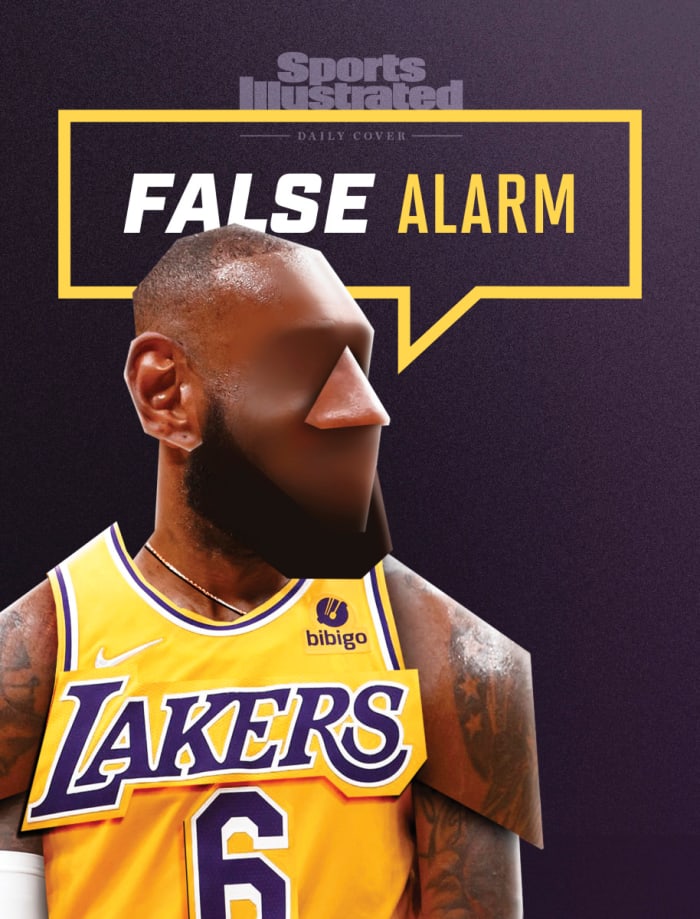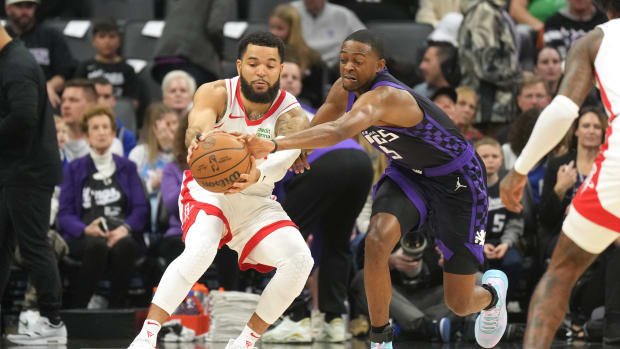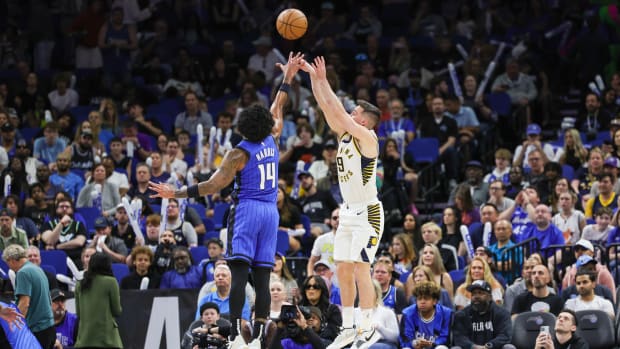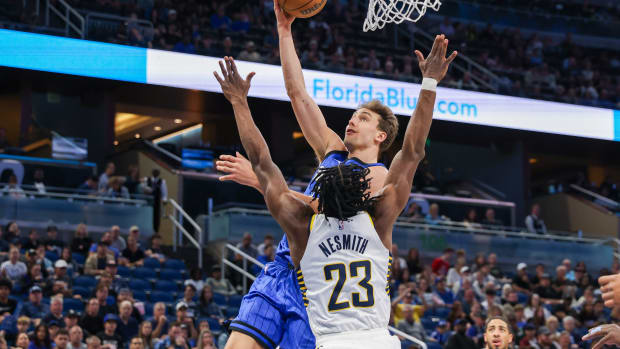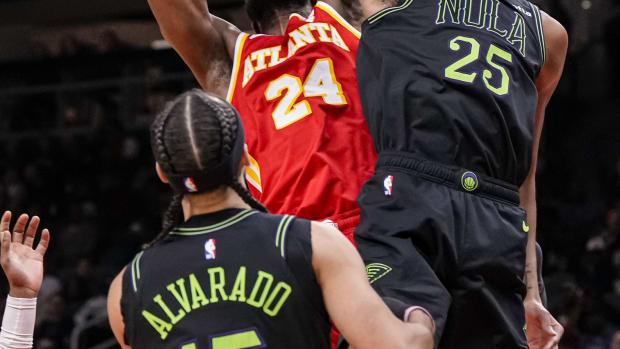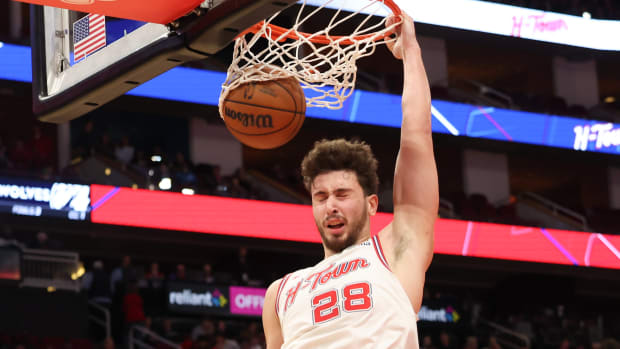The day after James Harden was traded from the Nets to the 76ers, a story started circulating about what the breaking point was between the 2018 league MVP and star Brooklyn guard Kyrie Irving. It posited that Irving beat Harden in one-on-one almost daily and that the Nets’ ballhandling wizard even once called his teammate “washed” after locking him up in a scrimmage. The tale spread across the Internet—a Google search for “Kyrie Irving James Harden washed” last month returned just under two million results—and eventually onto the airwaves of ESPN, being referenced thrice, by two different analysts, in two different months. And yet, the incidents in question never actually occurred.
Instead, the report originated on Twitter, from a tweet and accompanying graphic that received more than 40,000 likes. While the initial information was attributed to a “Brooklyn Nets executive,” its actual creator was @BallsackSports, an account that has amassed around 170,000 followers on the platform in the 10 months since its launch.
Twitter accounts that concoct fables about athletes, coaches and teams are nothing new. For instance, a quick search on the platform reveals dozens whose handles are slight variations on the names of prominent sports newsbreakers. (Remember when in 2014 @Ken_Rosenthal_, not to be confused with MLB insider @Ken_Rosenthal, broke the story about a trade involving David Price to the Tigers?) But last September, Ballsack Sports began with the intention, according to its founder, an Ohioan named Matt, of exposing how misinformation spreads online. It’s why when Matt was naming his account, he wanted a handle that was “as illegitimate as possible” and that wouldn’t blend in, a key difference from many other fake news sources. “I felt like I could do it under something as humorous and obscene and out there and so blatantly obvious as Ballsack Sports,” he says. “The logo itself was BS. It’s a play on bulls---.”
For months, despite its moniker being a clear tell, the account was successful at achieving virality. Graphics from the crude handle were cited as legitimate on FoxNews.com and on various basketball-centric websites. A digital community formed, in which followers often replied “You got sacked” on posts that succeed in duping. Current NBA players like Kevin Durant and Myles Turner follow the account, about which ESPN analyst JJ Redick once tweeted, “Ballsack Sports is the greatest thing to happen to NBA Twitter.” Individual Ballsack Sports “reporters”—they are not officially affiliated with the founder or original account—even started appearing online, and an Instagram account with nearly 500,000 followers, @ballsacksport, adopted the brand, initially without Matt’s knowledge.
For a month, from mid-May to mid-June, Matt deactivated the account, saying it had been a successful experiment that had run its course. However, in the last 10 days, Ballsack Sports has returned, with Matt saying he wants to use its platform not only to occasionally create more “harmless but humorous” graphics but also discuss topics unrelated to sports.
Back in January, 76ers president of basketball operations Daryl Morey went on a Philadelphia radio station, “imploring people not to get too attached to Ballsack Sports tweets and treat them seriously.” And while Morey’s plea may be apt when thinking about Ben Simmons trade rumors, the account’s existence has revealed lessons about Twitter, misinformation and the state of sports media. As Trail Blazers guard Damian Lillard once said, “I think we live in a world where a lot of morons can’t tell if something is real or fake.” Well … actually, Lillard didn’t say that. But Ballsack Sports did publish a graphic saying he did.
The most well-known Ballsack Sports graphic was conceived in a McDonald’s parking lot. In February, Matt felt inspired to riff on traditional old-head vs. new-head talk-show debates. Instead of picking a player to mimic who was drafted before LeBron James, he tried thinking of one who entered the league after LeBron but had already left the NBA. While waiting in the drive-through line, Matt pulled out his phone, scanned a Basketball Reference list of the 2004 NBA draft class and saw a name he thought was a perfect fit: “I’m like, that’s it right there. I love Josh Smith. He was cold, he’s been retired for quite a few years now.”
Most Ballsack graphics take around three to five minutes to create. This particular one, Matt says, “took a couple minutes longer,” as he wanted to find the perfect image and complement it with a quote that would lead to the most reach. He ordered two Diet Cokes, settled into a parking spot and started piecing the graphic together. “It’s a different game back then, much more physical,” Smith said in the image. “I don’t think [LeBron] has the jumpshot or skills to really consistently dominate defenses then as he does today. There’s so much spacing in today’s game. We had 2–3 guys on a star player any given night. Nothing was easy.” Matt posted it, and watched it take off.
Here is an important caveat to this story: Journalists, myself included, do make honest mistakes, and plenty of outlets, including the one I am writing for, do sometimes take buzzy quotes out of context; the point of this piece is not to shame any person or place. Nevertheless, hours after the Smith graphic was posted to Twitter, Outkick.com published an article with the headline, “Former NBA player Josh Smith says LeBron James wouldn’t have been able to dominate in his era.” The article—which was later deleted—was shared, via syndicate, on FoxNews.com and posted on Fox’s Twitter feed, which has more than 20 million followers. Ballsack Sports was explicitly mentioned in the story’s copy. “That’s when I was like, ‘You’ve got to be kidding me,’” Matt says.
Last September, Matt saw a tweet from 76ers center Joel Embiid in which the Philadelphia star voiced his frustrations with NBA Twitter. “Y’all have no idea how much this media makes up stuff for followers and shame on you for believing them,” Embiid wrote. That message was part of Matt’s impetus for creating Ballsack Sports. He wanted to make an outlet that could fabricate information and gain an audience doing so. “Success to me was achieving as much awareness as possible,” Matt says. He grew up reading stories from ESPN.com, Sports Illustrated and Bleacher Report, but most of his own sports consumption had been pared down to a headline and an image. “I feel a lot of the sports media, or media in general, has become like fast food in that sense,” he says. But when the Smith graphic was aggregated, even Matt was a bit surprised by how something that took mere minutes to create could have that kind of reach.
There is a 1993 New Yorker cartoon of a dog, sitting in a desk chair with a paw on a computer keyboard, looking down toward the floor at another pooch beside it. “On the Internet, nobody knows you’re a dog,” the one at the desk says.
Online, words can be masked in anonymity, giving way to added feelings of freedom. They can also be taken out of context. Leticia Bode, an associate professor at Georgetown whose research specializes in political communication, new media and misinformation, says that on social media a blurring of lines between misinformation and satire easily occurs. “When you take that same exact information totally out of context,” Bode says, “then it can easily become misinformation as soon as somebody buys into it.” Especially, she adds, “if they share it organically as if it is real.”
Michael Mirer, a visiting assistant professor at the University of Wisconsin-Milwaukee who studies the changing nature of journalistic professionalism with an emphasis on sports, notes that misinformation can also spread if users adopt formatting standards—for instance, using the word report or breaking to open a tweet, or sources tell [INSERT OUTLET NAME] at the end of it. Such easily replicated practices are why Awful Announcing once wrote an article headlined, “So why are there so many fake Adrian Wojnarowski Twitter accounts?” To a lesser extent, Matt also mimics the work of team social media accounts and various other outlets that frequently drum up graphics about NBA rumors, though his process is much less detailed. “I don’t even proofread,” he says. “And sometimes I make spelling errors and stuff like that and things just have gone viral regardless.”
If you had tuned into CBS Radio on the night of Oct. 30, 1938, you might have thought that Martians were invading New Jersey. For just under an hour, starting at 8 p.m., actor Orson Welles and the Mercury Theatre presented an adaptation of H.G. Wells’s novel The War of the Worlds, an event that revealed the power of fake news. A 23-year-old Welles, according to A. Brad Schwartz, a Ph.D. student at Princeton University and the author of Broadcast Hysteria: Orson Welles’s War of the Worlds and the Art of Fake News, wanted to entertain a national audience and tell a dramatic story in a fanciful way. But, says Schwartz, the famous broadcast ended up being “a moment where people were questioning the authenticity of what was coming to them over the airwaves in a way that they hadn’t been before.” Some listeners later wondered, in Schwartz’s words, “How will we know when news is news, or whether it’s just fiction?”
Decades later, as an increasing number of readers visited Ballsack Sports, Matt wanted people to ponder the same question. That’s why on March 1 he started more explicitly drawing attention to the literal components of his online graphics. He shared one in which Lillard said he deals with “so many morons everyday hating on my loyalty,” attributing the quote to a “42nd interview that never happened with Ballsack Sports.” Days after that, on March 5, Matt made an even more obvious plea for critical thinking, publishing a graphic, again featuring Lillard, with the phrase “Fake Quote” in the middle of it. A line at the top read, “Does a graphic mean a player actually said anything? NO! Can anyone download a pic of dame and add text? YES!” And a line at the bottom said: “Look for a link, or a story before responding. Do not take any graphic at face value.”
In explaining his goals, Matt says: “I really want to create a shift, in that sense, of media literacy. I was frustrated that so many people were biting and taking the bait.”
Brooklyne Gipson, an assistant professor of communication at the University of Illinois and a research fellow at the Harvard Kennedy School’s Shorenstein Center, notes that content that “is emotionally provocative” often circulates the most on social media. Mirer adds that audiences are “mostly just looking for things to mobilize [around].” Case in point: In November, a Ballsack Sports graphic featuring a fictitious excerpt purporting to be from Scottie Pippen’s biography in which Pippen said Jordan “ruined the game of basketball” spread across the internet.
Bode, the Georgetown professor, says the misinformation concept known as data void—high demand for information on a certain topic, with little information available—also helps explain Ballsack Sports’s rise. Such a data void, Bode says, was tied to the rise in COVID-19 misinformation in the spring of 2020. Now, as minute sports newsbreaks continue to become a larger part of the sports media ecosystem, and as audiences clamor for the smallest rumors, the lack of clear public information makes fake transactional tweets more likely to take off, as they did with Ballsack Sports.
Graphics tied to timely news—like the playoffs or free agency—also tend to pop. Less than 30 minutes after the 76ers’ second-round loss to the Heat in early May, Ballsack Sports displayed a picture of Harden with the quote, “I just want the best talent around me to win a championship. I’m not sure if we’re quite there.” Having taken only two shots in the second half of Game 6, Harden was a target of intense public discourse, making him, in that moment, an ideal Ballsack Sports subject.
More than a month later, as chatter around the Lakers’ offseason swirled online, Ballsack Sports shared a photo of the team’s former coach, Frank Vogel, alongside a tagline that said Vogel thought the 2020 NBA title felt “cheap.” It prompted Morey to weigh in on Twitter: “Guessing someone is going to get sacked on this one.”
Made-up quotes about professional basketball are generally an innocuous form of misinformation. Still, as CNN reporter (and fact-checking ace) Daniel Dale remarked on Twitter, “Thousands of people falling daily for fake athlete quotes posted by an account called ‘Ballsack Sports’ does not inspire great confidence in society’s capacity to deal with political misinformation.” Gipson, the Illinois professor, adds the fact that the work of Ballsack Sports was so often treated as real shows the challenges social platforms have in managing parody accounts and what happens when misinformation spreads. Once someone hears on SportsCenter that a text from LeBron played a role in Tom Brady’s return to the Buccaneers (a Ballsack Sports graphic stating this did make it onto the air), it’s hard to correct the record for a mass audience. Corrections, Gipson says, are “much more forgettable than the memory of the lie.”
Here’s a piece of news for a real graphic: Ballsack Sports is no longer a place to see only fake basketball reports. This spring Matt found himself using his account’s reach for other purposes. In the weeks leading up to his decision to shut it down, he tweeted about the importance of mental health awareness, the shooting that killed 10 people in Buffalo, the difference between explicit and implicit racial bias, and about microaggressions.
As a result of wading into such waters, he says he received some online backlash, whether because of the content of his tweets or that his satirical sports account was not sticking to sports. Matt says such responses “played a factor” in pushing him to temporarily deactivate Ballsack Sports, adding the act of creating fake sports graphics was “where I’m least passionate about in life right now.”
“Sometimes it might be a great message, but not from a messenger people are initially going to take seriously,” he says. “I know my account was still growing, but I didn’t want to create crazier quotes, more outlandish quotes, more harmful quotes to elicit more response. It’s just not who I am.”
Matt says over the last few months, he received offers to buy the account from him. But he passed, not wanting its potential monetization to be his priority. Instead, when discussing its current existence he harkens back to what he calls Ballsack’s “purposeful trajectory”: “to rise, to have its peak where awareness was being spread; captivating mainstream media; getting attention from journalists everywhere; and then phasing out as it was no longer needed.”
When explaining why he brought it back after a monthlong hiatus, Matt says he didn’t want it to lose all of its relevance, and, saying he still had a platform, he felt more comfortable continuing to tweet about nonsports topics on the account. He also says he is now less focused on growing the account than he once was, noting he will only craft graphics “here and there.”
And yet, scan Twitter and you’ll see that just because Matt won’t be mass-creating graphics, doesn’t mean such images aren’t being put out. There are still Ballsack Sports reporters like Lane Richardson, Ron Billmery and Rob Buchanan—none of them are Matt, and he is unaware of most of their real-life identities. A @BallsackSports Instagram account, run by someone he didn’t know, continues to produce graphics. Similarly themed accounts, like @ButtcrackSports (which recently fooled Trae Young) and @NutsackNetwork, continue to share fabricated statements as well. Fake sports graphics are not going away.
Gipson warns people, “If there’s something that makes you laugh, crazy, angry, stop and think for a second” before sharing it. Oh, and find its original source, too, or you too run the risk of being sacked.
More Daily Covers:
• Is Chet Holmgren the Future of Basketball?
• Armando Bacot Is Following the Money, Right Back to School
• The Mercury’s Tina Charles Always Adapts
• Inside the Warriors’ Long-Awaited Return to Glory






























